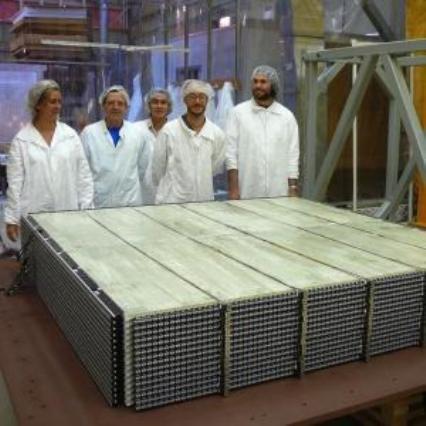

Today at the prestigious European Physical Society meeting in Stockholm, Sweden, TRIUMF's Michael Wilking announced a new breakthrough in understanding neutrinos, nature's most elusive particles. Together with Canadian, Japanese,and other international colleagues as part of the T2K collaboration, Dr. Wilking confirmed definitive observation of a new type of neutrino oscillation, in which muon neutrinos transform to electron neutrinos. It has been known that neutrinos transform from one kind into another, but this particular transition had never before been conclusively observed.
Scott Oser, UBC professor of physics and astronomy and spokesperson for the Canadian team known as T2K-Canada, commented, "Canada has been an international leader in neutrino research since the success of the Sudbury Neutrino Observatory(SNO). T2K was the logical next step after SNO in our quest to understand neutrino oscillations, and Canada was in fact the first international partner to join T2K. These new results are the culmination of a decade of work, and open the door to future studies of how both neutrinos and antineutrinos oscillate."
In the T2K experiment in Japan, a beam of muon neutrinos is produced in the Japan Proton Accelerator Research Complex, called J-PARC, located in Tokai, Ibaraki prefecture, on Japan's east coast. The neutrino beam is monitored by a nearby detector complex (much of which was built in Canada) and aimed at the gigantic Super-Kamiokande underground detector in Kamioka, near the west coast of Japan, 295 km (185 miles) away. An analysis of data from Super-Kamiokande associated with the neutrinos from J-PARC reveals that there are more electron neutrinos (a total of 28 events) than would be expected (4.6 events) without this new process.
In 2011, the collaboration announced the first hints of this process; now with 4.5 times more data this transformation is firmly established. The probability that random statistical fluctuations alone would produce the observed excess ofelectron neutrinos is less than one in a trillion. This T2K observation is the first of its kind to explicitly see a unique flavor of neutrinos appear at the detection point from a beam initially consisting of a different type of neutrino.
Neutrino oscillation is a manifestation of a long-range quantum mechanical interference. Observation of this new type of neutrino oscillation leads the way to new studies of charge-parity (CP) violation which provides a distinction between matter and antimatter. This phenomenon has only been observed in quarks (for which Nobel prizes were awarded in 1980 and 2008). CP violation in neutrinos in the very early universe may be the reason that the observable universe today is dominated by matter with no significant antimatter, which is one of the most profound mysteries in science. Now with T2K firmly establishing this form of neutrino oscillation that is sensitive to CP violation, a search for CP violation in neutrinos becomes a major scientific quest in the coming years, and T2K will lead the way. The T2K experiment expects to collect 10 times more data in the near future, including data with antineutrinos for studies of CPviolation in neutrinos.
MikeWilking said, "I chose to work on T2K because of the very important role it had to play in the search for CP violation. Now that the transition from muon neutrinos to electron neutrinos has been measured, and is quite large, the search for CP violation in neutrinos becomes very compelling. We are all now looking forward to the next phase of T2K, where we will begin to probe the CP asymmetry between neutrinos and antineutrinos."
For more information and media resources, please see http://triumf.ca/t2k.
--Based on a KEK press release
